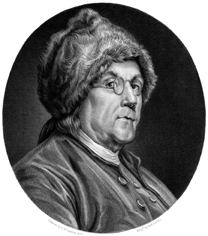In addition to being a father of the American Revolution, Ambassador to France, First Postmaster General of the United States, Governor of Pennsylvania, and inventor of the lightning rod, Franklin stove, and bifocal glasses, Benjamin Franklin was also an amateur meteorologist and oceanographer. Franklin observed that the severely cold winter of 1784 was preceded by an unusual haze, and he was the first to suggest that atmospheric contamination from volcanic eruptions might reduce the intensity of the sun’s energy reaching the Earth, resulting in winter weather so cold as to pose a hazard to society. The theory excerpted below was originally written as a letter and subsequently presented at a reading in 1784. In the letter, Franklin suggests that the “dry fog” observed in Europe and North America may have originated from Hecla (sic). Hekla, an Icelandic volcano, erupted in 1766 and not again until 1845. The eruption Franklin is referring to in his letter is almost certainly that of Lakagígar.
METEOROLOGICAL IMAGINATIONS and CONJECTURES
by BENJAMIN FRANKLIN.
During several of the summer months of the year 1783, when the effect of the sun's rays to heat the earth in these northern regions should have been greater, there existed a constant fog over all Europe, and great part of North America. This fog was of a permanent nature; it was dry, and the rays of the sun seemed to have little effect towards dissipating it, as they easily do a moist fog, arising from water. They were indeed rendered so faint in passing through it, that when collected in the focus of a burning glass they would scarce kindle brown paper. Of course, their summer effect in heating the earth was exceedingly diminished. Hence the surface was early frozen; Hence the first snows remained on it unmelted, and received continual additions. Hence the air was more chilled, and the winds more severely cold.
Hence perhaps the winter of 1783-4, was more severe, than any that had happened for many years.
The cause of this universal fog is not yet ascertained. Whether it was adventitious to this earth, and merely a smoke, proceeding from the consumption by fire of some of those great burning balls or globes which we happen to meet with in our rapid course round the fun, and which are sometimes seen to kindle and be destroyed in passing our atmosphere, and whose smoke might be attracted and retained by our earth; or whether it was the vast quantity of smoke, long continuing to issue during the summer from Hecla in Iceland, and that other volcano which arose out of the sea near that island, which smoke might be spread by various winds, over the northern part of the world, is yet uncertain . It seems however worth the enquiry, whether other hard winters, recorded in history, were preceded by similar permanent and widely extended summer fogs. Because, if found to be so, men might from such fogs conjecture the probability of succeeding hard winter, and of the damage to be expected by the breaking up of frozen rivers in the spring; and take such measures as are possible and practicable, to secure themselves and effects from the mischiefs that attended the last.
Published in Memoirs of the Literary and Philosophical Society of Manchester, 1789, (pp. 373-377). T. Cadwell in the Strand: London.
